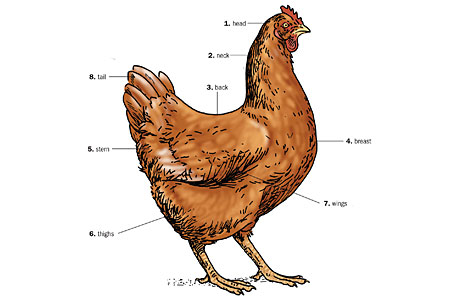
Each fall most chickens go through an annual molt, during which a shiny new set of feathers replaces their previous plumage. During the molt, nutrients used to produce eggs are diverted to producing feathers. As a result, laying slows, or ceases altogether. The best layers molt fast and furious, as if in a hurry to get back to the business of laying. The lazier hens molt slowly, and therefore lay fewer eggs over time. You can determine which is which by observing the molting sequence in chickens.
Molting Sequence
The molting sequence in chickens always occurs in a specific order. First to renew are the head feathers. Then, in order, feathers on the back, breast, stern, thighs, and wings. Last are the tail feathers.
The better layers normally lay for a year or more before molting. And they generally take between 14 and 16 weeks to complete the molt.
The poorer layers may lay for only a few months before going into a molt. And their molt may take as long as six months to complete. Because they drop and replace a few feathers at a time, your lazier hens tend to always look sleek and shiny.
Pin Feathers
You can gauge the length of the molting sequence in your chickens by watching for newly emerging pin feathers on each bird, particularly the head as molting begins, and the tail as molting is ending. Pin feathers are also called blood feathers, because they contain a supply of protein-rich blood to nourish the growing feather.
The blood-filled pin feathers, especially the highly visible ones around the tail and along the back, may attract picking. Picking occurs because the pickers crave additional protein during the molt.
Since your better layers drop more feathers at a time, they tend to have more concentrated pin feathers. They are therefore more likely to be the targets of picking, which can lead to cannibalism.
After the Molt
Once a feather is fully formed, the blood supply recedes and no further feather growth occurs. So a fully formed feather that breaks stays broken until the next molt. Because your better layers keep their feathers longer, their plumage may look rather rough as the next molt approaches.
Whether a hen is a lazy slow molter or a more productive fast molter, after the molt, her ability to convert feed into eggs will improve. Also her eggs will be larger and their quality will be better than they were prior to the molt.
Helpful Links
How to Help Your Chickens Through a Molt
And that’s today’s news from the Cackle Coop.
Gail Damerow has written numerous books about keeping poultry, many of them available from the Cackle Bookstore. The molting sequence illustration is from Storey’s Guide to Raising Chickens.

